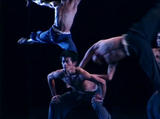|

Legacy.(Cloud.Gate.Dance.Theatre,.Lin.Hwai-min,.1978-2003).DVDRip.avi
Ранняя работа театра "Юньмэнь" -- своего рода "народная драма", повествующая о заселении Тайваня первой волной китайских эмигрантов в XVII в. Во время премьерной постановки это произведение, преисполненной героической символики, было воспринято в сугубо политическом ключе.
Театр "Юньмэнь" выступит в Москве 7, 8 и 9 июня 2007 г.:
http://chekhovfest.ru/pages/festival-2007/pesni-strannikov.php



| QUOTE |
| `Legacy' on view for free tonight (Taipei Times) CULTURE AND HISTORY: Cloud Gate Dance Theater turns 30 today and to celebrate, its signature work will be on view at the National Chiang Kai-shek Cultural Center By Jewel Huang STAFF REPORTER Thursday, Aug 21, 2003, Page 2 As the Taipei City Government declared today "Could Gate Day" in honor of the 30 years of achievements of Cloud Gate Dance Theater, the prestigious dance troupe will be performing Legacy, its signature work created 25 years ago, at the National Theater this evening. Although tickets sold out several weeks ago, the revival of Legacy will be simultaneously broadcast on four large screens in the plaza of the National Chiang Kai-shek Cultural Center at 7:45pm. People who cannot appreciate the performance at the theater or the plaza will be able to watch it on Public Television at 10pm. "Legacy presents the perseverance of our ancestors, which led us to move forward unrelentingly," Cloud Gate founder and choreographer Lin Hwai-min said. "I believe that there was a kind of impetus in Taiwanese society that helped Cloud Gate to exist so that we could go on for 30 years," said Lin. "What Cloud Gate has done is exemplified by Legacy: to advance bravely and to hold on." First staged on Dec. 16, 1978, the day that the US broke off diplomatic relations with Taiwan in favor of Beijing, Legacy brought the house down in Chiayi with the epic dance piece portraying the saga of the pioneers of Taiwan who crossed the "Black Water," now known as the Taiwan Strait, to settle in Taiwan before the 10th century. Tonight's performance is its 159th presentation and it will be performed by the dancers of three generations of Cloud Gate. The youngest dancer in the performance is 22 years old while the oldest is 40, Lin said. The San Francisco Chronicle lauded Legacy as "a moving document" for those who have never been to Taiwan. (http://www.taipeitimes.com/News/taiwan/archives/2003/08/21/2003064583) |
| QUOTE |
| I decided to do "Legacy" to honor the pioneers of Taiwan, our ancestors. With this thought came a problem: the stylized movement of opera or theatrical vocabularies of Graham technique would not fit the immigrants who were basically poor farmers. Upon my return to Taiwan, I took the dancers to a riverbed filled with rocks for outdoor training. We fast walked and ran on the rocks. We pushed and carried rocks. In the end we acquired a low weight stance, the typical body of farmers who always bent their bodies to labor on the land. From that position, dancers drew strength from floor and made explosive movements to eat up space, like pioneers claiming the land. "Legacy" is the first theatrical work that deals with the history of Taiwan. At that time, Taiwan was under Martial Law. To avoid the dangerous association with Taiwan Independence Movement by the government censors, I moved the premiere away from the capital, to a city near my hometown. By pure coincidence, "Legacy" premiered on the day the United States president Jimmy Carter announced the breakup with Taiwan and the establishment of diplomatic relationship with the People's Republic of China. People in Taiwan felt betrayed. The premiere became a highly emotional event: 6,000 people packed in a stadium. They cheered, cried and strove along with the dancers when the "pioneers" struggling to cross the "Black Water." With "Legacy", a work deeply rooted in our land and history, I felt I had finally come home. That nice feeling, however, did not last long. A pressing question constantly bugged me: What is the portrait of us, the present-day Taiwanese?.. (http://www.ispa.org/ideas/lin.html) |